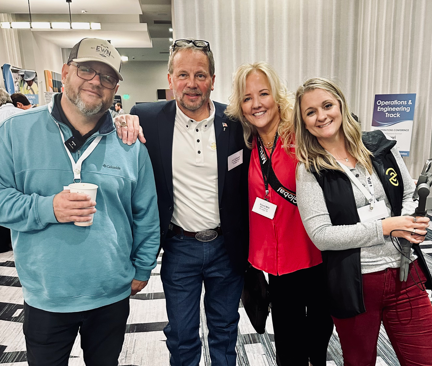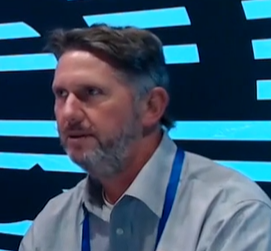Episode Transcript
Speaker 0 00:00:00 <inaudible>
Speaker 1 00:00:11 Good morning, everyone. Welcome back. Well, here we are completing one month of isolation. Feels like it might've been a day. Feels like it might've been a year, but we're making it every day. Today. We have episode three, almost sounds like something out of star Wars, but it is a big day. Cause we got some big guns with the pipeline safety management system information gurus, as I know them and I talk about them. So I'm excited to do that today. James, how are you today? I'm well, you know, Texas, Texas announced yesterday that we may be transitioning back on Friday. So there's an amount of terror and an amount of excitement, probably mixed all into a glove starting Friday. So we don't know what any of that looks like officially. Um, there's different phases and different groups coming back. But for us, I mean, I think we're just gonna stay the course, but kind of exciting to start seeing a light at the end of the tunnel a bit, but uh, appreciate everybody's time today. Thanks for the handoff. Uh, we've got a powerhouse crew today with us. I can say that because we're teammates and that's what teammates do. But before we get started, how does everyone let's just go around Jimmy, I'll start with you. How does everyone take their coffee? Well, I do an iced coffee, so it's not actually hot ice coffee in a clink and tried bug from the Pacific Northwest. Beautiful. Steve
Speaker 2 00:01:46 I've never met a cup of coffee. I didn't like unless they had sugar in it. So, um, this, this particular cup is a black decaf. Uh, I've found that recently if I drink too much coffee with the caffeine, I get a headache, but I'll, I'll drink a couple, two, three cups of, of, uh, uh, full strength with, uh, maybe cream in it. And then I transition over to a
Speaker 1 00:02:10 Decaf black full disclosure. I don't trust anybody that drinks decaf, but it's fine. We'll get through it today. Kelsey, how about you
Speaker 2 00:02:21 Diet mountain Dew. So I don't drink coffee, but in the spirit of today I had to put it in a coffee cup. So it'd be diet mountain Dew with Jim and James.
Speaker 1 00:02:31 You also can't trust that there's no value, but we are glad you're here. Thank you guys for joining us. Um, let's, let's jump right in today's episode, we have got the executive director of pipeline safety, Steve Allen, uh, we've already met tonight teammate and EWN, we're glad he's here Ms. Kelsey, clean blood. Uh, it's hard for me to say your last name. So I try not to. Kelsey is actually one of our newest teammates here and she's the director of pipeline. So normally we don't, we haven't had EWN folks on other than Gemini, but uh, we know how important this topic of PSMs and uh, we wanted to bring in the expert. So, um, honestly I can't go through all the acculate accolades that these two have because we're on a time crunch and honestly I can't keep track of it all. So Steve, first of all, welcome and look at that EWN shirt. The first time I've seen you, not in vivid overalls. Well, in stage probably looking at me on this first time, I've seen you not in a hoodie, uh, we've really, really embraced this lax virtual dress code, but, uh, Steve welcome.
Speaker 2 00:03:54 Are you saying that bib over girls aren't business guys?
Speaker 1 00:03:58 No, I I, it depends which state you're in, I think.
Speaker 2 00:04:01 Okay. Okay. Well, uh, good morning everybody. And uh, I'm really glad to be on coffee with Jim and James. Um, I have been challenged to keep this short, so I'm going to jump right into it. Um, but I want it, I need to frame the discussion, uh, regarding, uh, pipeline safety management systems and safety culture. Uh, as many of you probably know, American petroleum Institute recommended practice 1173 calls for, uh, operators to complete assessments of their safety cultures. Um, and then, um, uh, be able to track those, uh, and continually improve those, uh, many operators today have already performed, uh, safety assessments. Okay. So they're familiar with safety surveys, uh, and a lot of times those safety surveys are, uh, more geared towards occupational or personal safety as opposed to pipeline safety, which there is a distinction there with that. Now, um, I do want to read, uh, some captures out of the RP just cause I want to make sure that I quote them correctly.
Speaker 2 00:05:12 So just bear with me here. Okay. So, uh, the definition of safety culture safety culture is defined by ABI RPLs, every three as quote, the collective set of attitudes, values, norms, beliefs who practices, uh, that an operator's employees and contractor personnel share with respect to risk and safety. Um, API 1173 goes on to say, quote, although a positive safety culture can exist without a formal PSMs and effective PSMs cannot exist without a positive safety culture. Therefore operators should actively work to assess and improve their safety culture. So that's why this is such a big topic right now. Um, uh, and I can tell you it's, it's all about safety culture, a pipeline operator with a, with a poor safety culture is, is an accident waiting to happen. So, um, so as far as, uh, what we're talking about here is, is being able to assess, not evaluate, but assess a safety culture.
Speaker 2 00:06:21 Uh, there, there are, there's an accepted approach that basically is a three legged stool. Okay. So the first leg of that stool is to, to, uh, uh, take a look at the policies and procedures, um, uh, documentation of communication, uh, and anything you can get your hands on that basically, um, says, here's what the company is saying about pipeline safety culture. Uh, here's what an operator wants, how they want their employees to, to act and respond in certain circumstances in situations like, you know, uh, see something, say something, uh, documentation that might cover, um, you know, that employees should not, uh, fear any reprisal for speaking up and saying something. Those are that's type of documentation that you need to identify and evaluate to determine what the company says they want to have happen. Okay. The second leg of that stool is to, uh, survey, uh, the, the employees within the organization, as well as the contractors to, um, uh, gauge their perception of how, uh, that operator or their company, uh, values, safety and what they are doing to help, um, prevent mitigate, uh, certain threats and risks and so on and so forth.
Speaker 2 00:07:50 Um, so you go through and you, uh, number one, like I said, the first leg is you look at procedures and documentation records. The second leg is you do a, a perception survey to see, okay, so the company says, this is what they want to have happen. This is what the employees perceive. Okay. The third step is to actually go out and do a field observation to see what is actually going on to see whether or not there was any alignment with what the company says, what the employees perceive and what is actually going on. So, uh, I think I did a pretty good job keeping that pretty short and sweet. Um, both, we have a bet here on how long it's going to take, so I can't get into too long. I want to hedge my bet, but that anyhow, uh, Kelsey,
Speaker 1 00:08:34 I just got a quick question. Quick observation. Again, it sounds to me that companies have a lot of this in place right now, but they may not know it. And I think with these tips that you were talking about, these three, the three legs of the stool, they can take existing parts of the Hab and put it together and grow into a P SMS model. Is that
Speaker 2 00:08:57 That's a correct statement on two sides, one on the actual gap analysis of trying to gauge the conformity of a, of an organization with PSMs, but also, um, in, in, in assessing and continually trying to improve, improve safety culture, you know, you have to, you know, the old saying, if you, if you don't measure, if you can't measure it, you can't manage it. All right. So, uh, yeah, so I, I think you're, you're right. You're right. So, okay. Uh, Kelsey, could you talk a little bit about the analysis, uh, aspect of this and the perception survey tool that you've been developing for the last, uh, a couple of months?
Speaker 3 00:09:39 Sure. So overall, the completion of a safety culture assessment should include these following three elements in order to determine the alignment of first, what the company says they want to have happen. Second, what employees perception of the strength of the company's safety culture and how well the policies and procedures are being followed. And third, what is occurring in the field based on that field observation that Steve just spoke about, if all of the safety culture indicators are present in scoring well, amongst all three legs of the stool and threats are being mitigated a positive safety culture, um, showing that those are mitigated, then one could conclude that there's a sufficiently positive safety culture present. So the perception tool that Steve discussed, the survey we developed was, um, created by starting with the 10 elements that are outlined in RP, 1173. The questions are also tied to various SMS categories, such as issues or positive safety culture indicators that allow our survey platform to analyze the responses into easily view data and dashboards and reports so that it can highlight the problem areas that an organization is having, or also highlight positive areas so that they can then use that information to create a baseline of their culture perception.
Speaker 3 00:11:05 And as well as based on those results create an issue, we can create issue focused surveys so that organizations can identify specific areas of improvement and develop strategic strategies and solutions to try and resolve those issues. Um, our safety culture survey tool is an excellent way for a contractor or an operator to begin their SMS journey, as well as continue to evaluate, um, their organizational safety culture and their SMS program maturity. So it's a, it's a great tool that can be used by small companies, large companies. And it's a good start for a lot of people to begin their SMS journey.
Speaker 2 00:11:48 I raise my hand and then you answered it in the next sentence. But I was going to say, I know a lot people are going to ask,
Speaker 1 00:11:54 You know, whether they're a big operator or a small operator or a contractor, you know, is there a perfect approach for, for each, you know, for all three of those, is there a tailored approach in each of those situations?
Speaker 3 00:12:10 Right. So, yeah, we started out with just, we have these base questions that no matter what category you fall into, you're going to be asked these questions. That way you can be compared to different companies or throughout the industry, so that you have that comparison so that you can see where you're falling in line with other people. Or you can compare yourself with a company of similar size or not, you know, it leaves you open to be able to use that data, however you like.
Speaker 1 00:12:38 Gotcha. Perfect. That answers my question. Um, you know, we're seeing a lot more, I think, embrace PSMs and RP 1173, as we kind of rampant to it. I think, you know, people's questions are, you know, how do I get started at, you know, um, I joke with Steve the other day, one thing I always say kind of in my speaking presentations is almost one of my wrap-up and action items at the end is people would say, well, okay, how do I get started? And I'm like, man, just start, you know, start somewhere, reach out, you know, you can easily get tied up in analysis paralysis and do absolutely nothing. And so sometimes it's just getting started reaching out to the right people, um, and, and looking what that path looks like for you and your teams. So I think what you guys have brought up is a great start for that, for those that maybe it's a bit more foreign, you know, this is a good way to kind of ramp up into it.
Speaker 1 00:13:43 Uh, you don't, you know, it's really assessing what you're already doing. It's not saying right or wrong. It's looking at it first and analyzing that. So, uh, appreciate that, that time and kind of breaking that down for us. Uh, Steven, Kelsey, and Steve, I'll start with you. Uh, any final words just to sum it up then? Sure, sure, sure. Thanks, James. So many of you that do know me know that I'm a bit of a zealot when it comes to PSMs. Um, I mean, that's, that's what I do at PSMs advocate. Um, and, uh, with that I can't stress strongly enough, uh, of how, how important, uh, it's a paramount importance to have a positive safety culture. And in order to have positive safety culture, you need to assess, you need to know where you are and then set that, that baseline like Kelsey had mentioned, and then move forward with action items to try to close gaps and then measure it again. And then, you know, kind of the plan do check act approach, uh, you
Speaker 2 00:14:52 Know, so, um, for those who have not begun their, uh, PSMs journey, um, my recommendation and not everyone in the industry agrees with starting off with safety culture assessment, but I think it's a great place to start, uh, because it can be awfully revealing. So that would be, that would be my recommendation for those, uh, organizations, operators that have already begun their journey. Um, you might want to consider, uh, this three-legged approach, uh, to, to assessing your safety culture. You just don't go out and do a safety culture survey. That's not enough. You have to go out and find out what the company says. They want to have happen, how the employees perceive, uh, the company's actions and then what's actually going on. So Kelsey, you got anything to add to that?
Speaker 3 00:15:43 No, all, all good points. Um, my grades, it, it may not be a thing that everybody says you can start with or that they should start with. But like James said, it's, it's a starting point period. And it's, it's a good thing to help you identify some areas where you may not have realized that there are issues and you could possibly easily resolve them. You just didn't know that they were present until now. So it's a, it's a great tool to be able to have. And again, you can then use focus surveys to dig deeper into what you find out in the, in the general survey. So it it's a great way to start a PSMs.
Speaker 2 00:16:20 Yeah, it feels like sometimes you just don't know what you don't know. And so it's a great place to start. Great comments. Great way to wrap it up. Folks. I want to say thank you to everybody for tuning in. It's great. It's a blessing for us to be able to support our industry and our country during this time, a big shout out to our two guests that way and that way I want to thank you all for being here. Everybody stay safe, stay happy, the lights at the end of the tunnel, we're getting there and we can do it all together. So I just want to say, thanks everybody. Have a great day and catch us on the next episode. Stay tuned. It's going to be another exciting one with that we will sign off for now.
Speaker 4 00:17:05 Thank you.


